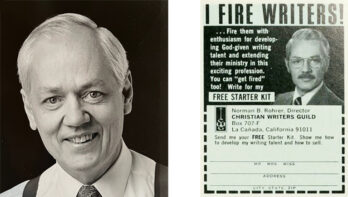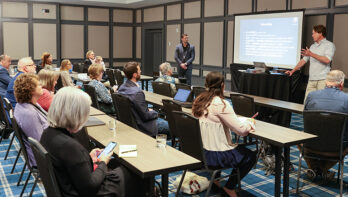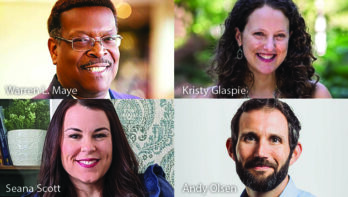
Jesus always had a heart for the marginalized. When He was telling a parable about the kingdom of God, Jesus said to “invite the poor, the crippled, the lame and the blind” (Luke 14:13 ESV).
Just as in Jesus’s day, people with disabilities are overlooked in modern culture. To provide a good witness to the disability community, it is essential that our content as Christian publications is disability inclusive.
Here are three tips on how to better minister to those with disabilities in EPA publications.
1. Include disabled voices.
There is a phrase in the disability rights movement: “nothing about us, without us.” Including disabled voices can mean hiring disabled writers. It can also mean allowing people with disabilities to share their own stories about their lives, ministries designed for them, and other topics that directly affect them.
It’s important to include disabled voices in your publication because no one understands disability more than disabled people themselves, and too often, non-disabled people default to asking caregivers instead of the disabled person himself or herself. Even in a specific scenario where a caregiver’s assistance may be required, it is the caregiver’s job to amplify the disabled person’s voice, not replace it.
Interviewing those with disabilities may sometimes require accommodations such as allowing a deaf or hard-of-hearing person to use an ASL interpreter during an interview or allowing a nonverbal person to take a few minutes to type a response to an interview question into a communication device. Another accommodation could be allowing a disabled person to interview via Zoom or phone rather than having them travel to your office, or offering to meet with them in their home or a place accessible to them.
A second important phrase within the disability community is “always assume competence.” Most people with disabilities are, at a minimum, competent enough to provide several quotes for your article, and many can do so much more, including completely writing their own stories.
2. Use proper terminology.
Proper terminology is constantly changing, and grace for yourself and others is crucial in this sensitive area. Still, as Evangelical Press Association members, we know words have power. Certain terms have certain connotations in the disability community, and using proper terminology communicates respect and inclusion.
One primary consideration is whether to include person-first language (“person with a disability”) or identity-first language (“disabled person”). Those who prefer person-first language tend to do so because they wish to communicate that disability is not the entirety of their identity. On the other hand, those who prefer identity-first language tend to do so because they see their disability as more of a neutral identity (like gender or race) rather than a negative aspect of their identity. In other words, those who use identity-first language wish to destigmatize the concept of disability. Currently, it is seen as best practice to ask your interview subject whether they prefer person-first or identity-first language.
Destigmatizing disability is a major theme in the terminology that disabled people tend to prefer. Although many families of those with disabilities and ministries use the term ‘special needs,” most adults with disabilities now find the term offensive. Other euphemisms, such as “differently-abled” and “handicapable,” are considered offensive as well. For the majority of the disability community, it is strongly preferred to simply use the term “disability.” Those with various conditions have specific preferred terms to use.
The AP Stylebook can be a trusted source with up-to-date language, and the National Center on Disability and Journalism provides even more specific and in-depth guidance.
When making decisions about language, it’s important to remember who you are writing to and what you are writing about. Ask the people you are writing about what terminology they prefer. Before making decisions about how to describe disability, consider whether disability is relevant to the story in the first place. Sometimes, a disabled person is simply a pastor, a missionary, a student, or a parent, for example, and his or her disability has no bearing on the specific article you are writing.
3. Make your content accessible.
The ultimate way to include people with disabilities in your content is to ensure they have access to it. Romans 10:14 (ESV) says, “How then will they call on him in whom they have not believed? And how are they to believe in him of whom they have never heard?”
In modern times, one may ask, “And how can they hear without proper accessibility?” Many times, web accessibility can even make your content accessible for non-disabled people.
Making sure your website can be accessible solely by keyboard helps those with temporary or permanent physical disabilities and those with a broken computer mouse.
Adding captions to videos helps those who are deaf or hard of hearing but also helps those who need to keep their volume low.
Using colors with good contrast helps those with color blindness or low contrast sensitivity but also helps those who may be looking at your screen in different lighting conditions.
Clear and understandable content helps those with cognitive and learning disabilities but also helps those who simply would prefer to skim through the website.
Text-to-speech not only helps those who are blind, visually impaired, or who have learning disabilities such as dyslexia but also people who are multitasking and prefer to listen to content rather than read it.
The World Wide Web Consortium (W3C) develops international standards for the Web and can be an excellent resource for making sure your content is accessible to all.
Creating disability inclusive content serves more people than you may realize. According to the Center for Disease Control, over 1 in 4 Americans identify as having a disability. According to the World Health Organization, around 1 in 6 people have a disability globally. Ensuring your content is disability inclusive removes barriers for billions of people and their families to hear your message.
With a journalism degree from Cedarville University and a lifetime of experience living as a woman with cerebral palsy, Jen Taggart uses her writing skills to advocate for the disability community in the church while working for a secular disability nonprofit. She is currently available for freelance opportunities. Reach out to her at jentaggart94 [at] gmail.com.
Posted February 19, 2025





